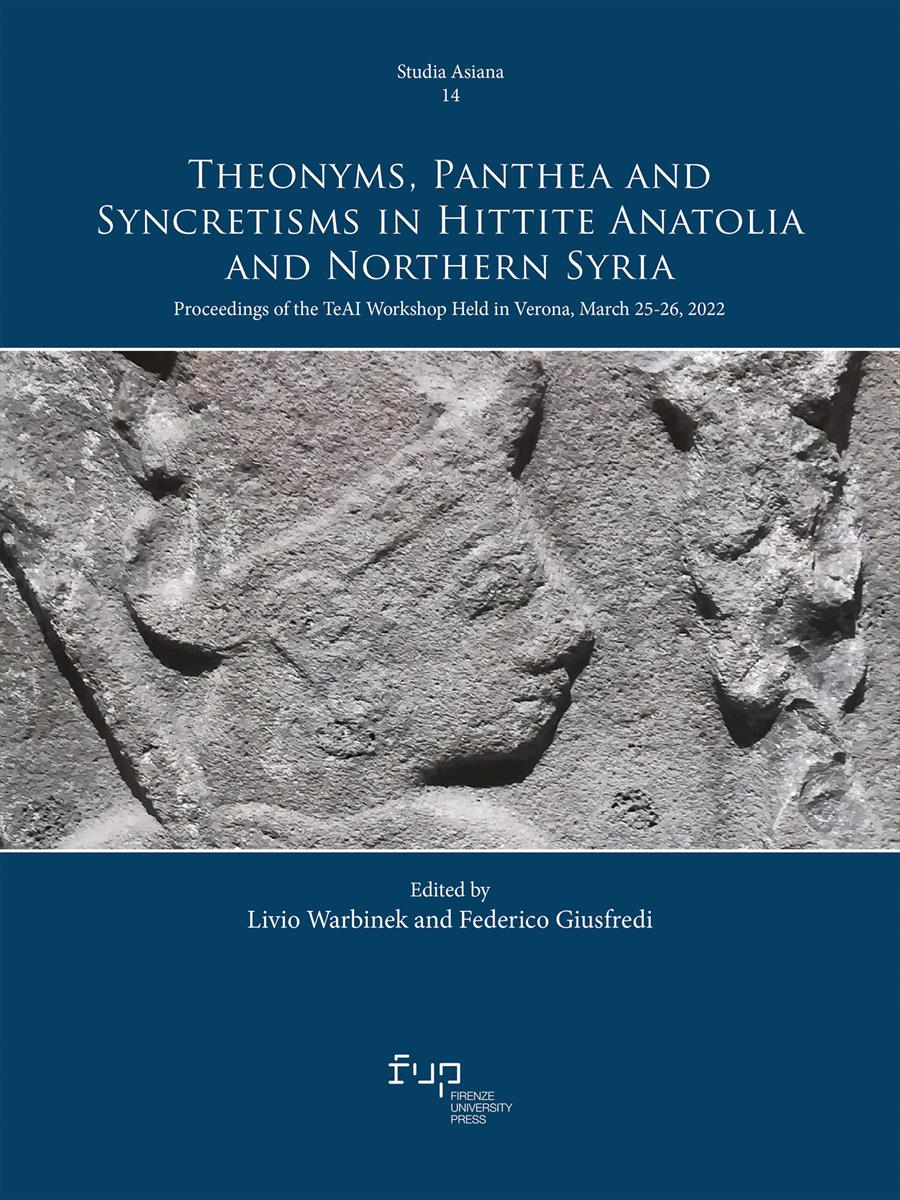- Theonyms, Panthea and Syncretisms in Hittite Anatolia and Northern Syria
- Edited by Livio Warbinek, Federico Giusfredi
Solar Deities in the Kuwattalla Ritual Tradition: Epithets and Functions
- Alice Mouton
- © 2023 Author(s) |
- CC BY 4.0
- DOI: 10.36253/979-12-215-0109-4.13
Through the contextual analysis of the occurrences of solar deities in the Kuwattalla ritual texts, we will try to sketch a portrait of these deities, focusing on their functions in the ritual process. Special attention will be paid to the combination of ritual gestures with Luwian incantations, since the latter might help to define the specificities of each member of this divine group.
- Keywords:
- Luwian,
- Hittite,
- Sun-deities,
- ritual texts,
CNRS, French National Centre for Scientific Research, France - ORCID: 0000-0003-4661-7762
- Christiansen, Birgit. 2012. Schicksalsbestimmende Kommunikation. Sprachliche, gesellschaftliche und religiöse Aspekte hethitischer Fluch-, Segens- und Eidesformeln. Wiesbaden: Harrassowitz (StBoT 53).
- Giorgieri, Mauro. 2002. “Birra, acqua ed olio: paralleli siriani e neo-assiri ad un giuramento ittita.” In Anatolia antica. Studi in memoria di Fiorella Imparati, eds Stefano de Martino, and Franca Pecchioli Daddi, 299-320. Florence: LoGisma (Eothen 11).
- Hutter, Manfred. 2003. “Aspects of Luwian Religion.” In The Luwians, ed. Craig Melchert, 211-80. Leiden – Boston: Brill (HdO I/68).
- Melchert, Craig H. 2019. “Solar and Sky Deities in Anatolian.” In QAZZU warrai. Anatolian and Indo-European Studies in Honor of Kazuhiko Yoshida, eds. Adam A. Catt, Ronald I. Kim, and Brent Vine, 239-49. Ann Arbor: Beech Stave Press.
- Miller, Jared L. 2004. Studies in the Origins, Development and Interpretation of Kizzuwatna Rituals. Wiesbaden: Harrassowitz (StBoT 46).
- Mouton, Alice. 2010. “Sorcellerie hittite.” Journal of Cuneiform Studies 62: 105-25.
- Puértolas Rubio, Laura. Forthcoming. “Appendix III: Deities and Impurity in the Puriyanni and Kuwattalla Traditions.” In Ilya Yakubovich, and Alice Mouton, Luwili. Hittite-Luwian Ritual Texts attributed to Puriyanni, Kuwattalla and Šilalluḫi (CTH 758–763). Wiesbaden: Harrassowitz (StBoT).
- Rieken, Elisabeth. 2017. “Schimpfen und Fluchen im Luwischen.” Indogermanische Forschungen 122: 241-51.
- Sasseville, David. 2020. Anatolian Stem Formation. Luwian, Lycian, and Lydian. Leiden: Brill (Studies in Indo-European Languages and Linguistics 21).
- Steitler, Charles W. 2017. The Solar Deities of Bronze Age Anatolia. Studies in Texts of the Early Hittite Kingdom. Wiesbaden: Harrassowitz (StBoT 62).
- van Gessel, Ben H.L. 1998. Onomasticon of the Hittite Pantheon 1-2. Leiden–New York–Köln: Brill (HdO I/33).
- Yakubovich, Ilya, and Alice Mouton. Forthcoming. Luwili. Hittite-Luwian Ritual Texts attributed to Puriyanni, Kuwattalla and Šilalluḫi (CTH 758–763). Wiesbaden: Harrassowitz (StBoT).
Chapter Information
Chapter Title
Solar Deities in the Kuwattalla Ritual Tradition: Epithets and Functions
Authors
Alice Mouton
Language
English
DOI
10.36253/979-12-215-0109-4.13
Peer Reviewed
Publication Year
2023
Copyright Information
© 2023 Author(s)
Content License
Metadata License
Bibliographic Information
Book Title
Theonyms, Panthea and Syncretisms in Hittite Anatolia and Northern Syria
Book Subtitle
Proceedings of the TeAI Workshop Held in Verona, March 25-26, 2022
Editors
Livio Warbinek, Federico Giusfredi
Peer Reviewed
Number of Pages
194
Publication Year
2023
Copyright Information
© 2023 Author(s)
Content License
Metadata License
Publisher Name
Firenze University Press
DOI
10.36253/979-12-215-0109-4
ISBN Print
979-12-215-0108-7
eISBN (pdf)
979-12-215-0109-4
Series Title
Studia Asiana
Series ISSN
1974-7837
Series E-ISSN
2612-808X
